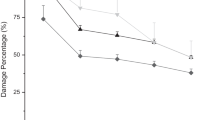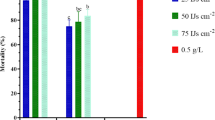Abstract
Graphosoma lineatum (Hemiptera: Pentatomoidae) is a polyphagia that feeds on plants from the Apiaceae family, including Foeniculum vulgare Mill., Daucus carota L., Ferulago campestris (Besser) Grecescu. It is reported as an important pest in our country, especially in anise production areas. In general, pests prefer generative organs of plants and harm them by feeding on maturing or matured seeds. Chemical control methods are usually preferred in the control of pests. The adverse effects of pesticides on humans and the environment enhance the importance of biological control. For this reason, possible biological control efforts against pests should be produced as an alternative to chemical control. For this purpose, commercially available biocontrol products including Nibortem (Verticillium lecani), Bio Magic (Metarhizium anisopliae), Nostalgist SL (Beauveria bassiana) and Priority SL (Paecilomyces fumosoreus) have been used against pests. Graphosoma lineatum adults used for the cultures in the experiment were collected by hand from D. carota plants found at the edge of the practice area of Ondokuz Mayıs University Agricultural Faculty. In the study, all the biocontrol products were applied by spraying a dose of 250 ml \ 100 lt water directly on to the G. lineatum adults. Experiments were conducted in 5 repeats and with 10 individuals. The study was checked daily and dead individuals were counted, and the counting continued for 8 days. As a result, it has been demonstrated that commercially available biocontrol products can control biocontrol the pests in question. As a result, we observed at the end of 8th day, the efficiency of B. bassiana was 100% while the mortality rate of P. fumosoroseus, M. anisopliae, and V. lecanii were 95.45%, 81.82%, and 68.18%, respectively. The isolates of Akça-2 and 27-1A were efficient at 90.91% and 95.45% respectively. Lethal time (LT) values were as mentioned below; LT90 values were; 1.43 days for Thiacloprid & Deltamethrin, 1.68 days for S. spinosa, 5.85 days for 27-1A, 6.15 days for Akça-2, 6.87 days for P. fumosoroseus, 6.95 days for B. bassiana, 6.96 days for Azadirachtin, 8.54 days for M. anisopliae and 8.93 days for V. lecanii. We concluded that B. bassiana, P. fumosoroseus, S. spinosa and the isolates from 27-1A, Akça-2, Azadirachtin had as a similar efficiency as Thiacloprid & Deltamethrin had. As a result, entomopathogenic fungi, bacteria and Azadiractin used in this study can be used against G. lineatum adults for organic control.
Similar content being viewed by others
Data availability
All data are available at the end of the article and the materials used in this work are of high quality and grade.
References
Abbott WS (1925) A method of computing the effectiveness of an insecticide. J Econ Entomol 18(2):265–267
Aksoy HM, Ozman-Sullivan SK (2008) Isolation of Bacillus megaterium from Aphis pomi (Homoptera: Aphididae) and assessment of its pathogenicity. J Plant Pathol:449–452
Aksoy HM, Ozman-Sullivan SK, Ocal H, Celik N, Sullivan GT (2008) The effects of Pseudomonas putida biotype B on Tetranychus urticae (Acari: Tetranychidae). In: Diseases of mites and ticks. Springer, Dordrecht, pp 223–230
Bellows TS, Fisher TW (1999) Handbook of biological control: principles and applications of biological control. (No. 632.96 B4)
Bınazzı F, Peverıerı GS, Sımonı S, Frosınını R, Fabbrıcatore T, Roversı PF (2015) An Effectıve Method for Graphosoma lıneatum (L.) long-term rearıng, REDIA, XCVIII, 155–160
Burnell A, Patricia SS (2000) Heterorhabditis, Steinernema and their bacterial symbionts—lethal pathogens of insects. Nematology 2(1):31–42
Cavados CFG, Fonseca RN, Chaves JQ, Rabinovitch L, Araújo-Coutinho CJPC (2001) Identification of entomopathogenic Bacillus isolated from Simulium (Diptera, Simuliidae) larvae and adults. Mem Inst Oswaldo Cruz 96(7):1017–1021
Erper I, Saruhan I, Akca I, Aksoy HM, Tuncer C (2016) Evaluation of some entomopathogenic fungi for controlling the green shield bug, Palomena prasina L.(Heteroptera: Pentatomidae). Egyptian Journal of Biological Pest Control 26(3):573
Fatiha L, Huang Z, Ren SX, Ali S (2008) Effect of Verticillium lecanii on biological characteristics and life table of Serangium japonicum (Coleoptera: Coccinellidae), a predator of whiteflies under laboratory conditions. Insect Science 15:327–333
Fent M, Aktaç N (1999) Taxonomic and Faunistic researches on Pentatomidae (Heteroptera) Fauna in Edirne region. Turkish Journal Zoology 23(2):377–395
Giray H (1980) The first list of pests in anise (Pimpinella anisum L.) in the Aegean region. Turkish Journal of Plant Protection 4:49–57
Gouli V, Gouli S, Skinner M, Hamilton G, Kim JS, Parker BL (2012) Virulence of select entomopathogenic fungi to the brown marmorated stink bug, Halyomorpha halys (Stål)(Heteroptera: Pentatomidae). Pest Manag Sci 68(2):155–157
Hall RA, Papierok B (1982) Fungi as biological control agents of arthropods of agricultural and medical importance. Parasitology 84(4):205–240
Khyami-Horani H, Katbeh-Bader A, Mohsen ZH (1999) Isolation of endospore forming bacilli toxic to Culiseta longiareolata (Diptera: Culicidae) in Jordan. Lett Appl Microbiol 28(1):57–60
Koçak E, Barış A (2009) Biological parameters of Graphosoma lineatum L. (Heteroptera, Pentatomidae) feeding on seeds of plants from Apiaceae family and suitable food selection. Bitki Koruma Bülteni 48(2):33–40
Lacey LA, Frutos R, Kaya HK, Vail P (2001) Insect pathogens as biological control agents: do they have a future? Biol Control 21(3):230–248
Lodos N (1986) Turkey Entomology (General, Applied and Faunistic) Volume II. Ege Uni. Faculty of Agriculture Publications Number:429, Bornova, 580
Lodos N, Önder F, Pehlivan E, Atalay R (1978) Studies on the detection of Pest insect Fauna of Aegean and Marmara region (Curculionidae, Scarabaeidae (Coleoptera); Pentatomidae, Lygaeidae, Miridae
Lopatinaa EB, Guseva IA (2019) A novel form of phenotypic plasticity of the thermal reaction norms for development in the bug Graphosoma lineatum (L.) (Heteroptera, Pentatomidae). Entomological Review 99(4):417–436
Meissle M, Romeis J (2009) Insecticidal activity of Cry3Bb1 expressed in Bt maize on larvae of the Colorado potato beetle, Leptinotarsa decemlineata. Entomologia Experimentalis et Applicata 131(3):308–319
Ozsahin E, Sezen K, Demir I, Demirbag Z (2014) Bacterial isolates from Palomena prasina (Hemiptera: Pentatomidae) include potential microbial control agents. Biocontrol Sci Tech 24(9):1039–1051. https://doi.org/10.1080/09583157.2014.918584
Özyurt N, Candan S, Suludere Z, Amutkan D (2013) Morphology and histology of the male reproductive system in Graphosoma lineatum (Heteroptera: Pentatomidae) based on optical and scanning electron microscopy. Journal of Entomology and Zoology Studies 1(4):40–46
Rampelotti FT, Ferreira A, Prando HF, Grützmacher AD, Martins JDS, Tcacenco FA, Mattos MLT (2007) Patogenicidade de Metarhizium anisopliae (Metsch.) Sorokin sobre as fases do desenvolvimento de Tibraca limbativentris Stal (Hemiptera: Pentatomidae) em condições de laboratório. Arq. Inst. Biol 74(2):141–148
Šlachta M, Vambera J, Zahradníčková H, Košťál V (2002) Entering diapause is a prerequisite for successful cold-acclimation in adult Graphosoma lineatum (Heteroptera: Pentatomidae). J Insect Physiol 48(11):1031–1039
Starnes RL, Liu CL, Marrone PG (1993) History, use and future of microbial insecticides. Am Entomol 39:83–91
Todorova SI, Cloutier C, Côté JC, Coderre D (2002) Pathogenicity of six isolates of Beauveria bassiana (Balsamo) Vuillemin (Deuteromycotina, Hyphomycetes) to Perillus bioculatus (F) (hem., Pentatomidae). J Appl Entomol 126(4):182–185
Toksöz Ș, Saruhan İ (2018) Efficiency of some bacterial isolates against green shield bug (Palomena prasina L., Hemiptera: Pentatomidae). In IX. International Scientific Agriculture Symposium" AGROSYM 2018", Jahorina, Bosnia and Herzegovina, 4–7 October 2018. Book of Proceedings (pp. 1143–1147). University of East Sarajevo, Faculty of Agriculture
Ünal E, Özsaraç M (1981) Preliminary studies on harmful and beneficial fauna in Marmara Region anise (Pimpinella anisum L.) fields. Zirai Mücadele Araştırma Yıllığı, 56–57
Waldron C, Madduri K, Crawford K, Merlo DJ, Treadway P, Broughton MC, Baltz RH (2000) A cluster of genes for the biosynthesis of spinosyns, novel macrolide insect control agents produced by Saccharopolyspora spinosa. Antonie Van Leeuwenhoek 78(3–4):385–390
Xu L, Ravnskov S, Larsen J, Nilsson RH, Nicolaisen M (2012) Soil fungal community structure along a soil health gradient in pea fields examined using deep amplicon sequencing. Soil Biol Biochem 46:26–32
Yiğit Ş, Saruhan İ, Akça İ (2019) Determination of mortality effects against Culex pipiens Linnaeus, 1758 (Diptera: Culicidae) larvae of different plant extracts. Turkish Journal of Weed Science 22(2):169–174
Yüceörs S, Karsavuran Y (2004) Graphosoma lineatum (L.) (Heteroptera: Pentatomidae)‘un besin tercihi üzerine araştırmalar. Ege Üniversitesi Ziraat Fakültesi Dergisi 41:57–64
Acknowledgements
My sincere thanks to Elif HİSAROĞLU and Rıfat AKÇA for their contribution to the study in the laboratory.
Funding
No funding.
Author information
Authors and Affiliations
Corresponding author
Ethics declarations
Ethics approval and consent to participate
Not applicable.
Additional information
Publisher’s note
Springer Nature remains neutral with regard to jurisdictional claims in published maps and institutional affiliations.
Rights and permissions
About this article
Cite this article
Yiğit, Ş., Saruhan, İ. Evaluation of biocontrol agents for Graphosoma lineatum (L.) (Hemiptera: Pentatomidae) in experimental conditions. Int J Trop Insect Sci 41, 1069–1074 (2021). https://doi.org/10.1007/s42690-020-00290-w
Received:
Revised:
Accepted:
Published:
Issue Date:
DOI: https://doi.org/10.1007/s42690-020-00290-w




